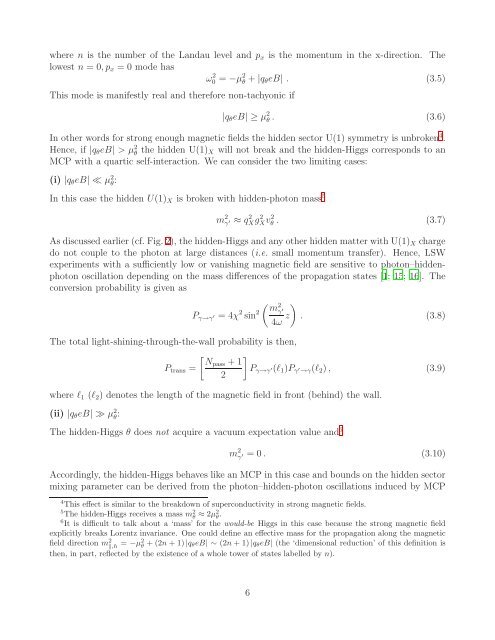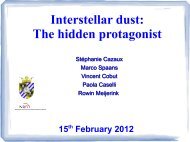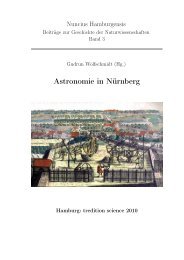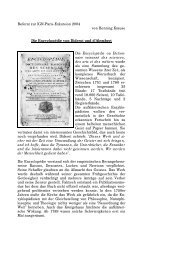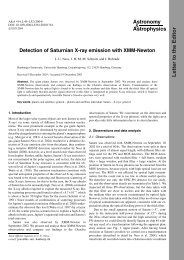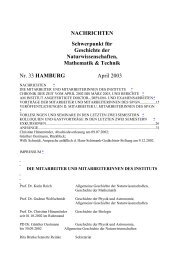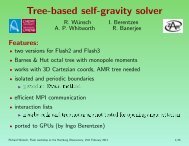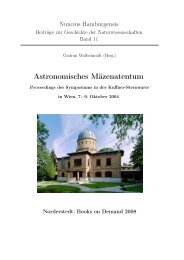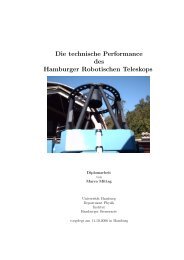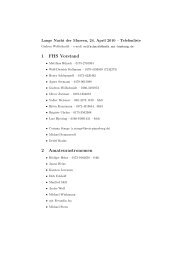Probing Hidden Sector Photons through the Higgs Window
Probing Hidden Sector Photons through the Higgs Window
Probing Hidden Sector Photons through the Higgs Window
Create successful ePaper yourself
Turn your PDF publications into a flip-book with our unique Google optimized e-Paper software.
where n is <strong>the</strong> number of <strong>the</strong> Landau level and p x is <strong>the</strong> momentum in <strong>the</strong> x-direction. The<br />
lowest n = 0, p x = 0 mode has<br />
ω 2 0 = −µ2 θ + |q θeB| . (3.5)<br />
This mode is manifestly real and <strong>the</strong>refore non-tachyonic if<br />
|q θ eB| ≥ µ 2 θ . (3.6)<br />
In o<strong>the</strong>r words for strong enough magnetic fields <strong>the</strong> hidden sector U(1) symmetry is unbroken 4 .<br />
Hence, if |q θ eB| > µ 2 θ <strong>the</strong> hidden U(1) X will not break and <strong>the</strong> hidden-<strong>Higgs</strong> corresponds to an<br />
MCP with a quartic self-interaction. We can consider <strong>the</strong> two limiting cases:<br />
(i) |q θ eB| ≪ µ 2 θ :<br />
In this case <strong>the</strong> hidden U(1) X is broken with hidden-photon mass 5<br />
m 2 γ ′ ≈ q2 Xg 2 Xv 2 θ . (3.7)<br />
As discussed earlier (cf. Fig. 2), <strong>the</strong> hidden-<strong>Higgs</strong> and any o<strong>the</strong>r hidden matter with U(1) X charge<br />
do not couple to <strong>the</strong> photon at large distances (i.e. small momentum transfer). Hence, LSW<br />
experiments with a sufficiently low or vanishing magnetic field are sensitive to photon–hiddenphoton<br />
oscillation depending on <strong>the</strong> mass differences of <strong>the</strong> propagation states [1; 15; 16]. The<br />
conversion probability is given as<br />
P γ→γ ′ = 4χ 2 sin 2 ( m<br />
2<br />
γ ′<br />
4ω z )<br />
. (3.8)<br />
The total light-shining-<strong>through</strong>-<strong>the</strong>-wall probability is <strong>the</strong>n,<br />
[ ]<br />
Npass + 1<br />
P trans = P γ→γ ′(l 1 )P γ<br />
2<br />
′ →γ(l 2 ) , (3.9)<br />
where l 1 (l 2 ) denotes <strong>the</strong> length of <strong>the</strong> magnetic field in front (behind) <strong>the</strong> wall.<br />
(ii) |q θ eB| ≫ µ 2 θ :<br />
The hidden-<strong>Higgs</strong> θ does not acquire a vacuum expectation value and 6<br />
m 2 γ ′ = 0 . (3.10)<br />
Accordingly, <strong>the</strong> hidden-<strong>Higgs</strong> behaves like an MCP in this case and bounds on <strong>the</strong> hidden sector<br />
mixing parameter can be derived from <strong>the</strong> photon–hidden-photon oscillations induced by MCP<br />
4 This effect is similar to <strong>the</strong> breakdown of superconductivity in strong magnetic fields.<br />
5 The hidden-<strong>Higgs</strong> receives a mass m 2 θ ≈ 2µ2 θ .<br />
6 It is difficult to talk about a ‘mass’ for <strong>the</strong> would-be <strong>Higgs</strong> in this case because <strong>the</strong> strong magnetic field<br />
explicitly breaks Lorentz invariance. One could define an effective mass for <strong>the</strong> propagation along <strong>the</strong> magnetic<br />
field direction m 2 ‖,h = −µ2 θ + (2n + 1) |q θeB| ∼ (2n + 1) |q θ eB| (<strong>the</strong> ‘dimensional reduction’ of this definition is<br />
<strong>the</strong>n, in part, reflected by <strong>the</strong> existence of a whole tower of states labelled by n).<br />
6


